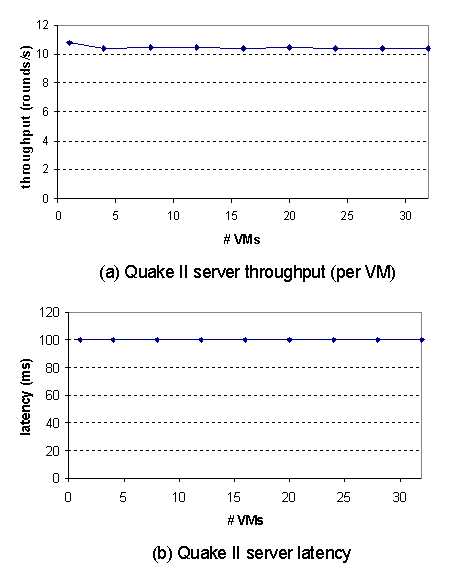
 [Next]
[Up]
[Previous]
[Next]
[Up]
[Previous]
As a second workload to test the scalability of Denali, we ported the GPL'ed Quake II game server to Ilwaco. Quake II is a latency-sensitive multiplayer game. Each server maintains state for a single game session; clients participating in the session send and receive coordinate updates from the server. We use two metrics as a measure of the quality of the game experience: the latency between a client sending an update to the server and receiving back a causally dependent update, and the throughput of updates sent from the server. Steady latency and throughput are necessary for a smooth, lag-free game experience.
To generate load, we used modified Linux Quake II clients to play back a recorded game session to a server; for each server, we ran a session with four clients. As a test of scalability, we measured the throughput and latency of a Quake server as a function of the number of concurrently active Quake VMs. Figure 12 shows our results.
As we scaled up the number of VMs (and the number of clients generating load), the average throughput and latency of each server VM remained essentially constant. At 32 VMs, we ran out of client machines to generate load. Even with this degree of multiplexing, both throughput and latency remained constant, suggesting that the clients' game experiences would still be good.

Figure 12: Quake II server scaling benchmarks: even with 32 concurrent active Quake II server VMs, the throughput and latency to each server remained constant. At 32 servers, we ran out of client machines to drive load.
Although the Quake server is latency-sensitive, it is in many ways an ideal application for Denali. The default server configuration self-imposes a delay of approximately 100 ms between update packets, in effect introducing a sizable ``latency buffer'' that masks queuing and scheduling effects in Denali. Additionally, because the server-side of Quake is much less computationally intensive than the client-side, multiplexing large numbers of servers is quite reasonable.